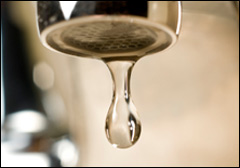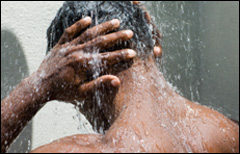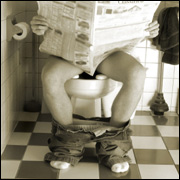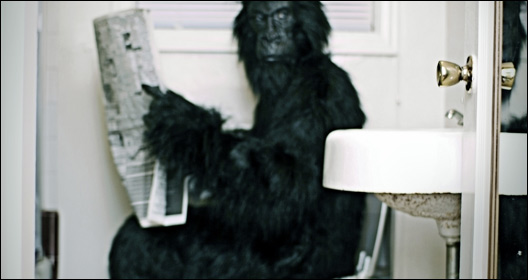
Splish splash, I was takin’ a bath
Long about a Saturday night
A-rub-dub, just relaxin’ in the tub
Thinkin’ everything was all right.
Poor Bobby Darin — there he was, thinking everything was all right, when he really should have been taking a four-minute shower under his low-flow showerhead. Of course, rewriting his movin’ and groovin’ ditty would be a musical crime. But water and energy waste (and their associated punch to the pocketbook) are also a crime of sorts. Luckily, they’re avoidable.
It’s tempting to think that what happens in the bathroom, like nudity, steamy affairs, and showerhead karaoke, should stay in the bathroom. But when it comes to, er, “going green,” we’re all in favor of sharing our habits. A few small changes will leave you clean of both body and conscience, while leaving enough water for the rest of us.
Here’s how to start.
Level One: The Baby Steps
Sink to green levels. Seriously, turn the faucet off while you brush your teeth — the EPA says this can save eight gallons of water every day. And drop two George Washingtons on a faucet aerator. Popping on with an easy twist, it’ll mix air into the water flow while maintaining pressure. Fix leaks too, since they can annually waste 2,700 gallons of H2O, as well as pouring money down the drain.

Raze the bar. While it may save water to pee in the shower (as long as you’re also lathering, urine luck!), shaving there is a no-no unless the water’s off. Depending on your shower’s flow — and it should be only about two gallons a minute — the time you spend gettin’ un-stubbly can waste a lot of water, not to mention the electricity used to heat it.
Level Two: The Next Steps
Dry your best. If “moist” is the most cringe-inducing word in the English language, towels are the solution. But conventional cotton production is heavy on pesticides, fertilizers, and bleach, as well as using huge amounts of water. Bamboo has recently hit the big time for being fast-growing, renewable, and anti-microbial; bamboo towel retailer Soft Forest also claims it’s softer and more absorbent than cotton. Bamboo towels — or organic cotton ones — ain’t always cheap, but here’s a rundown of organic cotton towels for any budget, and retailer Shirts of Bamboo is holding a timely “customer economic bailout sale.” For the cheapest eco-friendly drying of all, air-dry your locks — or at least wait 10 to 15 minutes before turning on the hair dryer. It’s better for your tresses and saves electricity.

Shower power. A bath can use up to seven times more water than a five-minute shower, so pull the plug. While you’re in the shower, try shutting off the water while you soap up (the “navy shower”). Less brutal options include taking a shorter shower (waterproof timers can help), turning your water heater down to 120 degrees F, and installing a low-flow showerhead (you’ll use half as much water as before). This popular low-flow showerhead is plastic-free, won’t break the bank, and has a valve for pausing water flow. Or for more desperate measures, this shower monitor displays the amount of hot water left and then beeps persistently till the shower goes off. And remember, when it comes to your shower curtain: no vinyl, and that’s final!
Elect to change your cabinet. Don’t dash out and buy a ton of new stuff, but when you need a replacement for something, consider organic and cruelty-free versions of your bathroom staples, like eco-friendly shaving cream, deodorant, and nail polish. Or opt for reusable and recycled options: Recycline makes toothbrushes and razors out of old yogurt cups; they even provide a postage-paid envelope to return the razor when you’re done with it. When you’re getting ready for your close-up, ditch disposable face wipes or puffs in favor of a trusty washcloth or makeup brush. And for all the ladies, choose alternatives to those chlorine-bleached, disposable pads and tampons.
Feeling industrious? Make your own toothpaste, soap, or lotion; or try body sugaring instead of shaving — each requires only a few ingredients.
Level Three: The Big Step
Go bowling. A leaky toilet can waste 90,000 gallons of water monthly, so squirt some dark food coloring into the tank to check for leakage. If you have an old-school toilet that uses 3.5 gallons of water per flush (most pre-1992 models), it could be responsible for nearly a third of household water use, so by all means invest in a low-flush 1.6-gallon model. The EPA estimates a family of four will annually save $90 by using a high-efficiency toilet (and has a list of models [PDF]).

Other options include retrofitting your porcelain throne to give it different flush options for No. 1 and No. 2 (that is, if you ain’t fond of letting it mellow) or, least optimally, diverting tank water with something like a pebble-filled plastic bottle — just don’t use a brick, as it’ll break down over time. Better yet, flush your toilet with water collected from the shower and sink, called graywater. To go totally waterless, get a composting toilet — no one will ever call you a party pooper again.
Resources
Water conservation
U.S. EPA’s WaterSense
American Water Works Association
Ask Umbra on water conservation
Ask Umbra on long, hot showers
Eco-friendly bathroom items
Grist reviews green deodorants, shaving creams, toothpastes, lotions, nail polishes, and feminine products
Ask Umbra on shaving
Ask Umbra on that time of the month
Ask Umbra on buying a non-vinyl shower curtain
Toilet info
U.S. EPA’s list of high-efficiency toilets [PDF]
Two-flush toilet retrofit
Envirolet composting toilets
The Humanure Handbook
Ask Umbra on composting toilets


